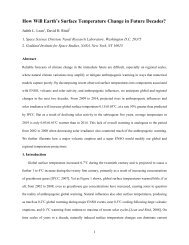Effects of Lower Magnetic Fields on the Thermosphere-Ionosphere
Effects of Lower Magnetic Fields on the Thermosphere-Ionosphere
Effects of Lower Magnetic Fields on the Thermosphere-Ionosphere
Create successful ePaper yourself
Turn your PDF publications into a flip-book with our unique Google optimized e-Paper software.
1/19<br />
<str<strong>on</strong>g>Effects</str<strong>on</strong>g> <str<strong>on</strong>g>of</str<strong>on</strong>g> <str<strong>on</strong>g>Lower</str<strong>on</strong>g> <str<strong>on</strong>g>Magnetic</str<strong>on</strong>g> <str<strong>on</strong>g>Fields</str<strong>on</strong>g> <strong>on</strong><br />
<strong>the</strong> <strong>Thermosphere</strong>-I<strong>on</strong>osphere<br />
Erdal Yiğit 1 , and Aar<strong>on</strong> J. Ridley 1<br />
1 University <str<strong>on</strong>g>of</str<strong>on</strong>g> Michigan, Ann Arbor, USA<br />
email: erdal@umich.edu<br />
Sunspot Workshop<br />
Sunspot, New Mexico, USA, 19 - 22 September 2011<br />
◭◭<br />
◮◮<br />
◭<br />
◮<br />
Back<br />
Close
C<strong>on</strong>tents<br />
1 Introducti<strong>on</strong> - Science Questi<strong>on</strong> 3<br />
2/19<br />
2 Introducti<strong>on</strong> - Earth’s <str<strong>on</strong>g>Magnetic</str<strong>on</strong>g> Field 4<br />
3 Model Descripti<strong>on</strong> 6<br />
4 Model C<strong>on</strong>figurati<strong>on</strong>s 8<br />
5 Model Simulati<strong>on</strong>s 10<br />
6 Model Results 11<br />
7 Electr<strong>on</strong> Density Distributi<strong>on</strong>s 12<br />
8 Temperature and Neutral Flows 14<br />
9 Meridi<strong>on</strong>al Flow & Electr<strong>on</strong> Density 15<br />
10 Temperature Variati<strong>on</strong>s 16<br />
11 Summary and C<strong>on</strong>clusi<strong>on</strong> 17<br />
◭◭<br />
◮◮<br />
◭<br />
◮<br />
Back<br />
Close
Introducti<strong>on</strong> - Science Questi<strong>on</strong><br />
This Study<br />
How does<br />
3/19<br />
decreasing magnetic field impact<br />
<strong>the</strong> <strong>the</strong>rmosphere-i<strong>on</strong>osphere<br />
system<br />
◭◭<br />
◮◮<br />
◭<br />
◮<br />
Back<br />
Close
Introducti<strong>on</strong> - Earth’s <str<strong>on</strong>g>Magnetic</str<strong>on</strong>g> Field<br />
• Tilted <str<strong>on</strong>g>of</str<strong>on</strong>g>fset dipole field<br />
• Variable: magnitude and distributi<strong>on</strong><br />
• Magnitude decreased in <strong>the</strong> last 150 years 10-15% and still decreasing...<br />
• Geophysical (dynamics, chemistry) and biological impacts (pige<strong>on</strong>s,<br />
bees).<br />
4/19<br />
◭◭<br />
◮◮<br />
◭<br />
◮<br />
Back<br />
Close
Research Strategy & Outcome<br />
This study<br />
A General Circulati<strong>on</strong> Model that simulates<br />
<strong>the</strong> <strong>the</strong>rmosphere-i<strong>on</strong>osphere self-c<strong>on</strong>sistently<br />
+<br />
<str<strong>on</strong>g>Lower</str<strong>on</strong>g> <strong>the</strong> magnetic field density<br />
↓<br />
Quantify <strong>the</strong> changes in <strong>the</strong><br />
<strong>the</strong>rmosphere-i<strong>on</strong>osphere<br />
5/19<br />
◭◭<br />
◮◮<br />
◭<br />
◮<br />
Back<br />
Close
Model descripti<strong>on</strong>-I<br />
Global I<strong>on</strong>osphere <strong>Thermosphere</strong> Model (GITM)<br />
• First principle n<strong>on</strong>hydrostatic general circulati<strong>on</strong> model (GCM)<br />
described in <strong>the</strong> work by Ridley et al. (2006)<br />
• Vertical extent: 100-∼650 km<br />
• Variable time step 2-4 s.<br />
• Variable flexible grid resoluti<strong>on</strong>, e.g., 5 ◦ × 5 ◦ , 0.3125 ◦ × 2.5 ◦<br />
(Yiğit and Ridley, 2011)<br />
• GSWM, MSIS tidal forcing<br />
• 2-way self-c<strong>on</strong>sistent <strong>the</strong>rmosphere-i<strong>on</strong>osphere coupling<br />
• Vertical momentum equati<strong>on</strong> explicitly solved.<br />
• Part <str<strong>on</strong>g>of</str<strong>on</strong>g> <strong>the</strong> Space Wea<strong>the</strong>r Modeling Framework (SWMF)<br />
6/19<br />
◭◭<br />
◮◮<br />
◭<br />
◮<br />
Back<br />
Close
Model descripti<strong>on</strong>-II<br />
Global I<strong>on</strong>osphere <strong>Thermosphere</strong> Model (GITM)<br />
• Dynamics: i<strong>on</strong> drag, advecti<strong>on</strong>, tides, etc.<br />
• Solar and Magnetospheric input:<br />
- Joule heating<br />
- Auroral heating<br />
- High-latitude electric fields<br />
- Interplanetary magnetic field (IMF)<br />
- Solar F10.7 flux<br />
- Solar wind speed<br />
• Chemistry: Neutral densities <str<strong>on</strong>g>of</str<strong>on</strong>g> O, O 2 , N( 2 P ), N( 2 D), S( 2 P ), N 2 ,<br />
and NO; and i<strong>on</strong> species O + ( 2 P ) ,O + 2 , N + ,O + ( 4 S), O + ( 2 D), N + 2 ,<br />
and NO +<br />
7/19<br />
◭◭<br />
◮◮<br />
◭<br />
◮<br />
Back<br />
Close
Model C<strong>on</strong>figurati<strong>on</strong>s<br />
Input<br />
• Variable F10.7, hemispheric power, and IMF c<strong>on</strong>diti<strong>on</strong>s from observati<strong>on</strong>s<br />
• Empirical high-latitude electric fields (Weimer, 2005)<br />
• Auroral particle precipitati<strong>on</strong> (Fuller-Rowell and Evans, 1987)<br />
• MSIS lower boundary fields<br />
8/19<br />
◭◭<br />
◮◮<br />
◭<br />
◮<br />
Back<br />
Close
Model C<strong>on</strong>figurati<strong>on</strong>s: Input<br />
10<br />
5<br />
9/19<br />
Bx (nT)<br />
0<br />
-5<br />
-10<br />
10<br />
By GSM (nT)<br />
5<br />
0<br />
-5<br />
Bz GSM (nT)<br />
-10<br />
10<br />
5<br />
0<br />
-5<br />
-10<br />
20<br />
Figure 1: Heliospheric variati<strong>on</strong>s from<br />
30 Aug - 1 Sept 2008.<br />
Vx (km/s)<br />
Density (/cc)<br />
15<br />
10<br />
5<br />
0<br />
-350<br />
-400<br />
-450<br />
-500<br />
-550<br />
Aug 30 Aug 31 Sep 01 Sep 02<br />
Aug 30 to Sep 02, 2001 Universal Time<br />
◭◭<br />
◮◮<br />
◭<br />
◮<br />
Back<br />
Close
Model Simulati<strong>on</strong>s and Methodology<br />
Period <str<strong>on</strong>g>of</str<strong>on</strong>g> simulati<strong>on</strong>s<br />
• 30 August - 1 September 2008<br />
• Analysis <str<strong>on</strong>g>of</str<strong>on</strong>g> 1 September 2008<br />
10/19<br />
Reducing <strong>the</strong> magnetic field<br />
I. B 100%<br />
II. B 95%<br />
III. B 90%<br />
IV. B 85%<br />
V. B 80%<br />
Then calculate <strong>the</strong> differences with respect to I.<br />
◭◭<br />
◮◮<br />
◭<br />
◮<br />
Back<br />
Close
Electr<strong>on</strong> density distributi<strong>on</strong>s - 1200 UT<br />
95% 90%<br />
[e-] at 394.6 km Altitude 31-AUG-01 12:00:00.000<br />
[e-] at 394.6 km Altitude 31-AUG-01 12:00:00.000<br />
100.0 m/s<br />
100.0 m/s<br />
30<br />
30<br />
11/19<br />
20<br />
20<br />
18<br />
00<br />
-7.35 3.97<br />
10<br />
0<br />
-10<br />
-20<br />
-30<br />
[e-]<br />
18<br />
00<br />
-14.73 9.78<br />
10<br />
0<br />
-10<br />
-20<br />
-30<br />
[e-]<br />
Figure 2: Polar distributi<strong>on</strong>s <str<strong>on</strong>g>of</str<strong>on</strong>g><br />
relative electr<strong>on</strong> density changes<br />
in percentage for decreasing magnetic<br />
fields <strong>on</strong> 31 Aug 1200 UT.<br />
Relative changes i<strong>on</strong> flows are<br />
overplotted.<br />
[e-] at 394.6 km Altitude 31-AUG-01 12:00:02.000<br />
100.0 m/s<br />
10<br />
18<br />
0<br />
-10<br />
-20<br />
-30<br />
00<br />
85% 80%<br />
-22.51 17.67<br />
100.0 m/s<br />
30<br />
20<br />
[e-]<br />
[e-] at 394.6 km Altitude 31-AUG-01 12:00:00.000<br />
18<br />
00<br />
-30.30 27.13<br />
30<br />
20<br />
10<br />
0<br />
-10<br />
-20<br />
-30<br />
[e-]<br />
• v enhanced dramatically at<br />
high-latitudes.<br />
• n e increases around midnight<br />
at midlatitudes, while everywhere<br />
else n e decreases.<br />
◭◭<br />
◮◮<br />
◭<br />
◮<br />
Back<br />
Close
Electr<strong>on</strong> density distributi<strong>on</strong>s - 0000 UT<br />
95% 90%<br />
[e-] at 394.6 km Altitude 01-SEP-01 00:00:00.000<br />
100.0 m/s<br />
30<br />
[e-] at 394.6 km Altitude 01-SEP-01 00:00:00.000<br />
100.0 m/s<br />
30<br />
12/19<br />
20<br />
20<br />
18<br />
00<br />
-2.05 6.59<br />
10<br />
0<br />
-10<br />
-20<br />
-30<br />
[e-]<br />
18<br />
00<br />
-4.42 13.33<br />
10<br />
0<br />
-10<br />
-20<br />
-30<br />
[e-]<br />
Figure 3: Polar distributi<strong>on</strong> <str<strong>on</strong>g>of</str<strong>on</strong>g><br />
relative electr<strong>on</strong> density change<br />
in percentage for decreasing magnetic<br />
fields <strong>on</strong> 1 Sept 0000 UT.<br />
Relative changes i<strong>on</strong> flows are<br />
overplotted.<br />
18<br />
[e-] at 394.6 km Altitude 01-SEP-01 00:00:00.000<br />
100.0 m/s<br />
00<br />
85% 80%<br />
-7.08 23.44<br />
30<br />
20<br />
10<br />
0<br />
-10<br />
-20<br />
-30<br />
[e-]<br />
[e-] at 394.6 km Altitude 01-SEP-01 00:00:00.000<br />
100.0 m/s<br />
18<br />
00<br />
-10.06 35.45<br />
30<br />
20<br />
10<br />
0<br />
-10<br />
-20<br />
-30<br />
[e-]<br />
• v enhanced dramatically at<br />
high-latitudes!<br />
• n e increases around midnightdawn<br />
at midlatitudes, while<br />
everywhere else n e decreases.<br />
◭◭<br />
◮◮<br />
◭<br />
◮<br />
Back<br />
Close
Electr<strong>on</strong> density distributi<strong>on</strong>s: Lat-l<strong>on</strong><br />
50.0 m/s<br />
95% [e-] at 394.6 km Altitude at 01-SEP-01 00:00 UT<br />
-5.33 6.59<br />
6<br />
4<br />
2<br />
0<br />
-2<br />
-4<br />
-6<br />
[e-]<br />
Figure 4: Latitude-l<strong>on</strong>gitude distributi<strong>on</strong>s<br />
<str<strong>on</strong>g>of</str<strong>on</strong>g> relative electr<strong>on</strong> density<br />
change in percentage for cases<br />
95% and 80% magnetic fields. Relative<br />
changes i<strong>on</strong> flows are overplotted.<br />
13/19<br />
80% [e-] at 394.6 km Altitude at 01-SEP-01 00:00 UT<br />
50.0 m/s<br />
-26.38 35.45<br />
20<br />
0<br />
-20<br />
[e-]<br />
• Electr<strong>on</strong> density increase around<br />
midlatitudes and decrease at<br />
high-latitudes<br />
• I<strong>on</strong> flows are faster at highlatitudes.<br />
• Hemispheric differences.<br />
◭◭<br />
◮◮<br />
◭<br />
◮<br />
Back<br />
1<br />
Close
Temperature and Neutral Flows<br />
Temperature at 394.6 km Altitude at 01-SEP-01 00:00 UT<br />
10.0 m/s<br />
Temperature at 394.6 km Altitude at 01-SEP-01 00:00 UT<br />
10.0 m/s<br />
14/19<br />
0.03 1.07<br />
1.0<br />
0.8<br />
0.6<br />
0.4<br />
Temperature<br />
0.2<br />
0.0<br />
0.10 2.36<br />
2.0<br />
1.5<br />
1.0<br />
Temperature<br />
0.5<br />
0.0<br />
Temperature at 394.6 km Altitude at 01-SEP-01 00:00 UT<br />
50.0 m/s<br />
0.18 3.90<br />
4<br />
3<br />
Temperature<br />
2<br />
1<br />
0<br />
Temperature at 394.6 km Altitude at 01-SEP-01 00:00 UT<br />
1<br />
Figure 5: Relative percentage difference in temperature.<br />
Difference in neutral flows are overplotted.<br />
100.0 m/s<br />
0.26 5.71<br />
5<br />
4<br />
Temperature<br />
3<br />
2<br />
1<br />
0<br />
◭◭<br />
◮◮<br />
◭<br />
◮<br />
Back<br />
Close
Meridi<strong>on</strong>al Flow & Electr<strong>on</strong> Density<br />
15/19<br />
Figure 6: Merisi<strong>on</strong>al flow and electr<strong>on</strong> density at a<br />
high-latitude.<br />
◭◭<br />
◮◮<br />
◭<br />
◮<br />
Back<br />
Close
Temperature Variati<strong>on</strong>s<br />
16/19<br />
Figure 7: Universal<br />
time variati<strong>on</strong> <str<strong>on</strong>g>of</str<strong>on</strong>g><br />
neutral temperature at<br />
68.75 ◦ , 2.5 ◦ E at 394<br />
km <strong>on</strong> 31 August.<br />
◭◭<br />
◮◮<br />
◭<br />
◮<br />
Back<br />
Close
Summary and C<strong>on</strong>clusi<strong>on</strong><br />
I<strong>on</strong> flows<br />
• With decreasing magnetic field, <strong>the</strong> i<strong>on</strong>s become faster E × B/B 2<br />
→ Variati<strong>on</strong>s in i<strong>on</strong> drag and Joule heating are expected!<br />
→ Changes in dynamics and heat balance<br />
• Variability (future work)<br />
17/19<br />
Electr<strong>on</strong> density distributi<strong>on</strong>s<br />
With decreasing B from 100 to 80%<br />
• 6-35% increase in n e at midlatitudes at night<br />
• Up to –35% change in n e at high-latitudes<br />
◭◭<br />
◮◮<br />
◭<br />
◮<br />
Back<br />
Close
Summary and C<strong>on</strong>clusi<strong>on</strong> (c<strong>on</strong>t’d)<br />
Temperature and neutral flows<br />
• Temperatures increase overall up to 5% (SH high-latitudes)<br />
• Neutral flows are enhanced with decreasing B becoming more<br />
equatorward during <strong>the</strong> night.<br />
→ effects <strong>on</strong> chemistry<br />
• I<strong>on</strong> drag and Joule heating probably play a great role (future study).<br />
18/19<br />
Future Work<br />
• Modeling <strong>the</strong> Sun-Earth c<strong>on</strong>necti<strong>on</strong>.<br />
• Impact <str<strong>on</strong>g>of</str<strong>on</strong>g> solar variability at various scales.<br />
• Observati<strong>on</strong>al implicati<strong>on</strong>s<br />
• I<strong>on</strong> drag and Joule heating.<br />
◭◭<br />
◮◮<br />
◭<br />
◮<br />
Back<br />
Close
References<br />
Fuller-Rowell, T. J., and D. S. Evans (1987), Height-integrated Peders<strong>on</strong> and Hall c<strong>on</strong>ductivity patterns inferred from<br />
TIROS-NOAA satellite data, J. Geophys. Res., 92, 7606–7618.<br />
19/19<br />
Ridley, A. J., Y. Deng, and G. Tóth (2006), The global i<strong>on</strong>osphere–<strong>the</strong>rmosphere model, J. Atmos. Sol.-Terr. Phys., 68,<br />
839–864.<br />
Weimer, D. R. (2005), Improved i<strong>on</strong>ospheric electrodynamic models and applicati<strong>on</strong> to calculating Joule heating rates,<br />
J. Geophys. Res., 110, A05306, doi:10.1029/2004JA010884.<br />
Yiğit, E., and A. J. Ridley (2011), <str<strong>on</strong>g>Effects</str<strong>on</strong>g> <str<strong>on</strong>g>of</str<strong>on</strong>g> high-latitude <strong>the</strong>rmosphere heating at various scale sizes simulated by a<br />
n<strong>on</strong>hydrostatic global <strong>the</strong>rmosphere-i<strong>on</strong>osphere model, J. Atmos. Sol.-Terr. Phys., 73, 592–600, doi:10.1016/j.jastp.<br />
2010.12.003.<br />
◭◭<br />
◮◮<br />
◭<br />
◮<br />
Back<br />
Close




![When the Heliospheric Current Sheet [Figure 1] - Leif and Vera ...](https://img.yumpu.com/51383897/1/190x245/when-the-heliospheric-current-sheet-figure-1-leif-and-vera-.jpg?quality=85)

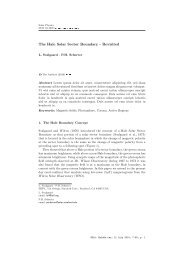
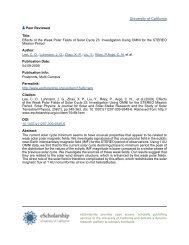

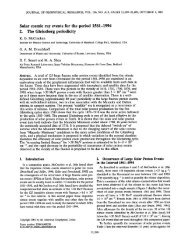
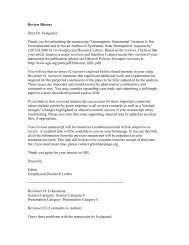

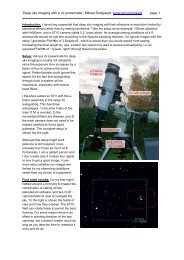
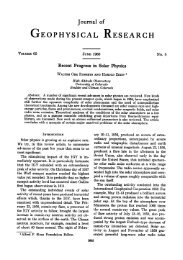
![The sum of two COSine waves is equal to [twice] the product of two ...](https://img.yumpu.com/32653111/1/190x245/the-sum-of-two-cosine-waves-is-equal-to-twice-the-product-of-two-.jpg?quality=85)
